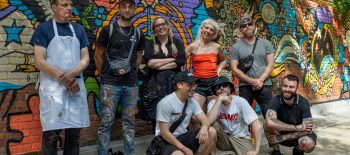Exhibition Kus + Libera
On view: September 7-October 21, 2023
Events
Tuesday, September 5 at 5pm ET: Pre-Opening Concert by Shahzad Ismaily and Michał Dymny Duo (details below)
Thursday, September 7 at 6-8:30pm ET: Exhibition Opening Reception
Thomas Erben Gallery
526 West 26th Street, Floor 4, New York NY 10001
Polish Cultural Institute New York presents Kus + Libera, featuring the work of Agata Kus, in her US debut, and Zbigniew Libera. The show, opened on September 7, is supported by the Polish Cultural Institute New York and co-curated by its Curator of Visual Arts and Design, Izabela Gola. On view are recent photo works by critically lauded and prominently exhibited conceptualist Zbigniew Libera (b. 1959) as well as paintings by Agata Kus (b. 1987), who is part of the current surge of mainly young, female, figurative painters, and whose work has garnered widespread attention. Libera began working in the early 1980’s, behind the “iron curtain” in a Poland seeking to free itself from Soviet rule, whereas the art of Kus’s generation operates within and confronts a market-oriented, now capitalist society. The juxtaposition of their work shows how two artists – 30 years apart in age and brought up under opposite political systems – respond to their contemporary situation.
Realizing how and why each artist triggers and recontextualizes collective memories is key to understanding their work. Whereas Kus depicts her contemporary female protagonists in decayed interiors, recalling the neoclassical architecture of 19th century Poland in a time of heightened patriotism in the face of over a century long partitions – Libera often builds his photos from images sourced from popular visual culture and mass media or what he calls, “the piles of images in our heads”. In Libera’s work, there is a friction between what is implied and what might be seen in his often emotionally exalted, staged scenarios, which have been the subject of many exhibitions over the years. Each scene of estranged, obscured marginalized worlds trigger imagination to reveal the camouflaged stories. The invented characters are caught in action in often seemingly historical moment.
For example, Poetess Maria de Cyrano (2020), is reminiscent of the 1960’s Civil Rights-era photograph of African American girl Ruby Bridges being escorted by police so that she can attend elementary school. While this connection draws us in, the work confounds on multiple levels. It presents a mob of elegantly, upwardly dressed men in drag, who – in a reversal of the conventional social order – assault and attack the central figure, a middle-aged woman, stoically marching and protectively clutching Julius Shulman’s A Constructed View, which documents Los Angeles’ mid-century architecture. Could the modest poetess be the reason for this aggression or perhaps the book, an ode to “modernity”? And as the figure of a guard intrudes from the right of the picture, is he deliberately trying to keep us out? What are we not supposed to see? Immersed in grotesque and satire, the portrayed subjects hint at seemingly familiar lived experience. Unlike the pieces of a jigsaw puzzle, which together form a cohesive image, Libera lets a multitude of possible narrative interpretations collide without offering resolution. Althoughsolely constructed, his pictures comment on reality or following Libera’s words, “even though not true, they carry the truth”.
Likewise, though rendered in oil on canvas as well as engaging a long tradition of symbolism and mysticism, Kus juxtaposes images to equally open-ended, enigmatic ends. The viewer is immediately pulled by visual richness of seductive figurative scenes, sometimes sourced from the artist’s life, arrived at with a skillful painterly style of an academic painter. Unlike in Libera, young women are staged static, in a post-action or a post- event, detached from their deteriorating, almost postapocalyptic surroundingsof a passed era (fin de siècle). The vignettes of every-day activities are transformed into strange magical or ritualistic acts, imbued with melancholy or decadence.
Young woman in her Come and See (2023) sits atop the skeleton of a horse, rendered after a prop used by Tadeusz Kantor in one of his experimental theatre pieces, Let the Artists Die (1985). The morbidity of the scene is softened with cutesy details, such as hair clips in the horse’s mane or a tail-wagging, little dog. While Kus’s theatrical tableaux evoke a grand past, their dilapidated interiors point toward its collapse. This creates a stark contrast with Kus’ young women, who – though presented as self-possessed and materially well off, considering their up-to-date fashions – are portrayed as unmoored, disengaged, and mainly gazing at their iPhones. A new peculiar kind of mythology emerges from the visual allegories blending Kus’ personal and collective memories: a reflection on contemporary state of conscious, cultural phenomena, identity crisis, social degeneracy, coming of age or post adolescent repressed fears and anxieties, or perhaps longing for an attempted but unfulfilled revolutionary act.
In both bodies of work, there is a dialogue between past and present. Whereas Libera sees a possibility for a change – Kus presents us with a contemporary condition in stasis. But her inclusion of religious symbols, removed as they might seem from official iconography – such as the likeness of St. Mary, her face bisected by the canvas edge or her tears of blood replaced by rhinestones – hint at the possibility of redemption amidst a crisis of meaning.
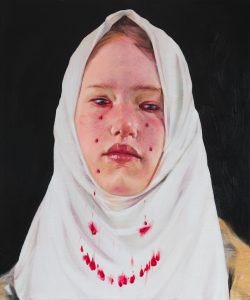
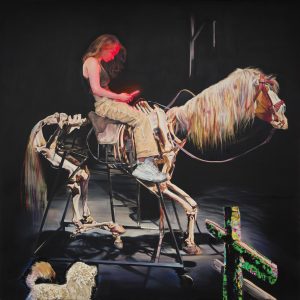
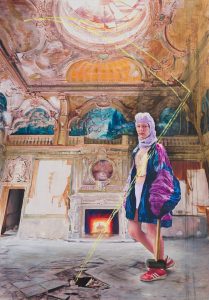
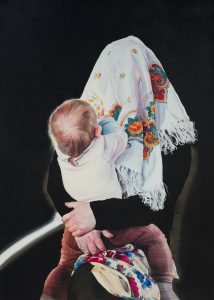
Agata Kus was born in 1987. She lives and works in Krakow, Poland. She graduated from Faculty of Painting at the Academy of Fine Arts in Krakow. She completed her diploma at the studio of Professor Leszek Misiak in 2012. She received her PhD in 2018. She works in painting, drawing, video and ceramic. She is a recipient of many awards and scholarships, including the Grand Prize at the International Media Art Biennale WRO 2015. In 2017, she was nominated for “The Views” Deutsche Bank and Zachęta National Gallery of Art Award. In 2011 and 2018, she was shortlisted for the Vordemberge-Gildeward Award. In 2021, she won the first place in the ranking of young artists „Kompas Młodej Sztuki”, published in the „Rzeczpospolita” newspaper. She cooperated with galleries and institutions in Poland, Austria and Paris. Her paintings are in the collection of the MOCAK Museum of Contemporary Art in Krakow, National Museum in Gdańsk, Bunkier Sztuki Gallery in Kraków, M Bank Collection and in many private collections in Poland and abroad.
Kus primarily paints people, consistently with the current triumphant return to this classic type of figurativeness. Her trademark use of multiple narratives within a single composition allows a multi-faceted reading of the painting as individual themes or a synthesis of them all, resulting in new meanings. The elusiveness and ambiguity of Kus’s paintings offers many possibilities for interpreting and following their complex narratives. The artist uses a wide range of formal procedures such as pictorial collage, pseudo-cutouts, paste-ins, obliterations and destructions to suggest a juxtaposition of many differently textured and executed compositions.
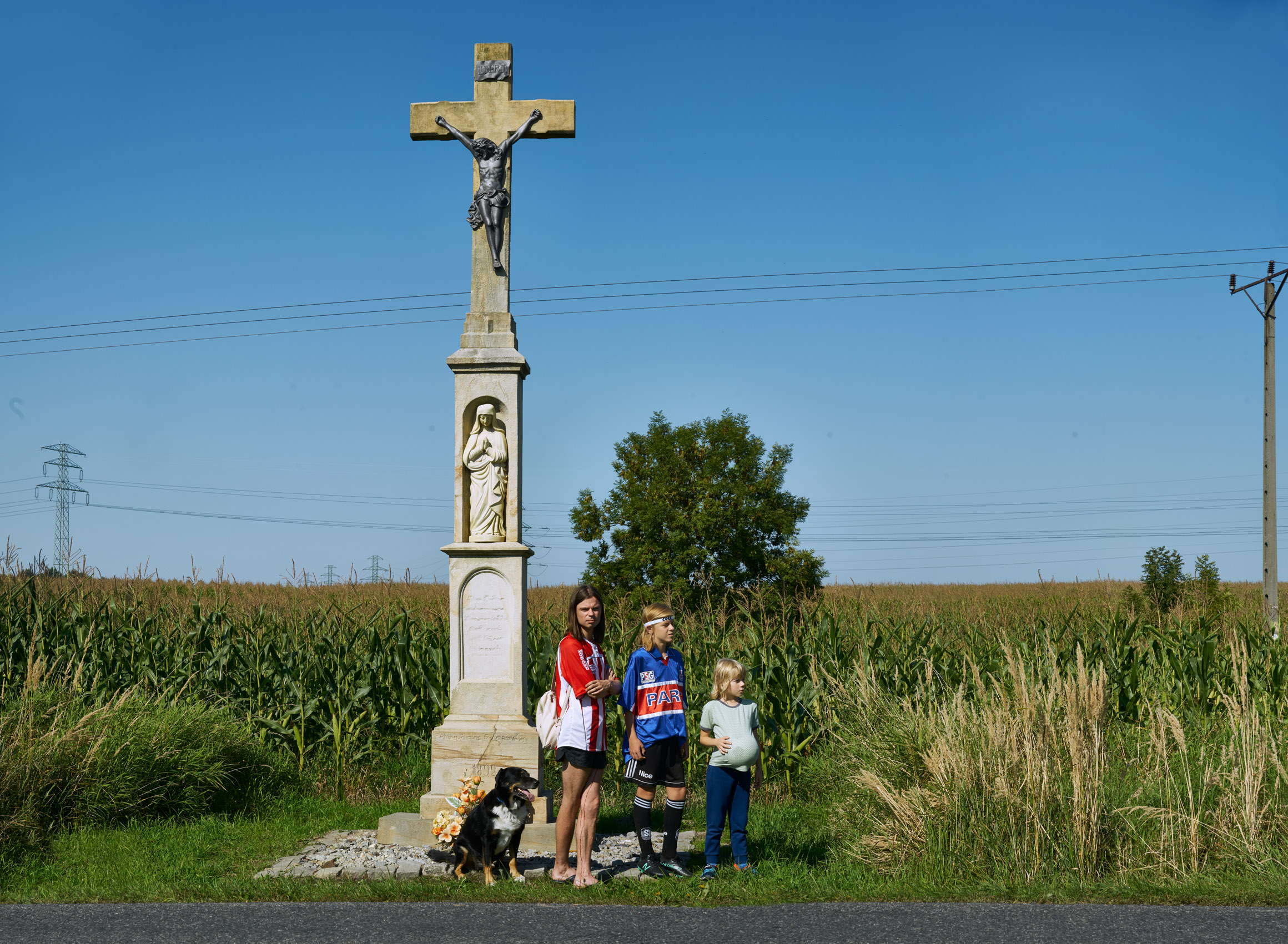
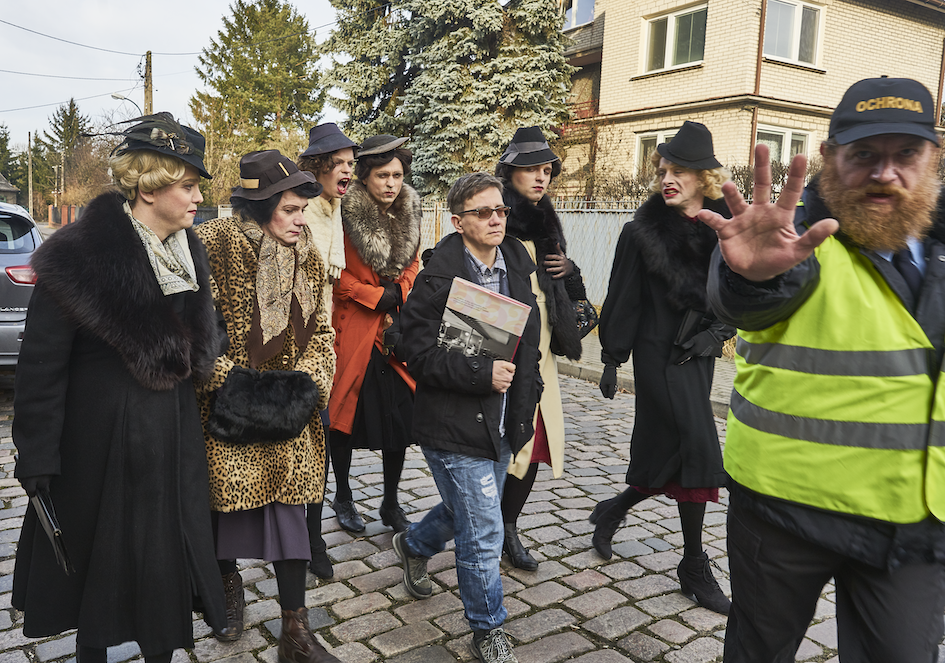
Zbigniew Libera (born 7 July 1959) is a Polish artist, born in Pabianice, Poland. Libera’s artworks are considered to fall under the styles of pop art and critical art, and have been frequently used his works to comment on political and social issues. Considered one of the most renowned Polish artists to date, Libera considers himself the “Father of Critical Art”. Libera is best known for his controversial 1996 artwork named LEGO Concentration Camp, depicting a Nazi concentration camp made out of Lego bricks. The artwork attracted much controversy, including The Lego Group threatening legal action. Libera is also famous for his photography and videography such as Intimate Rites (1984), How to Train Little Girls (1987) and Pozytywy (English: Positives). ‘’Pozytywy’’ is a series featuring Libera’s photographs that capture humans living in war-torn cities.
The exhibit Kus + Libera is initiated by the Polish Cultural Institute New York, co-curated and produced in close partnership with Thomas Erben Gallery.
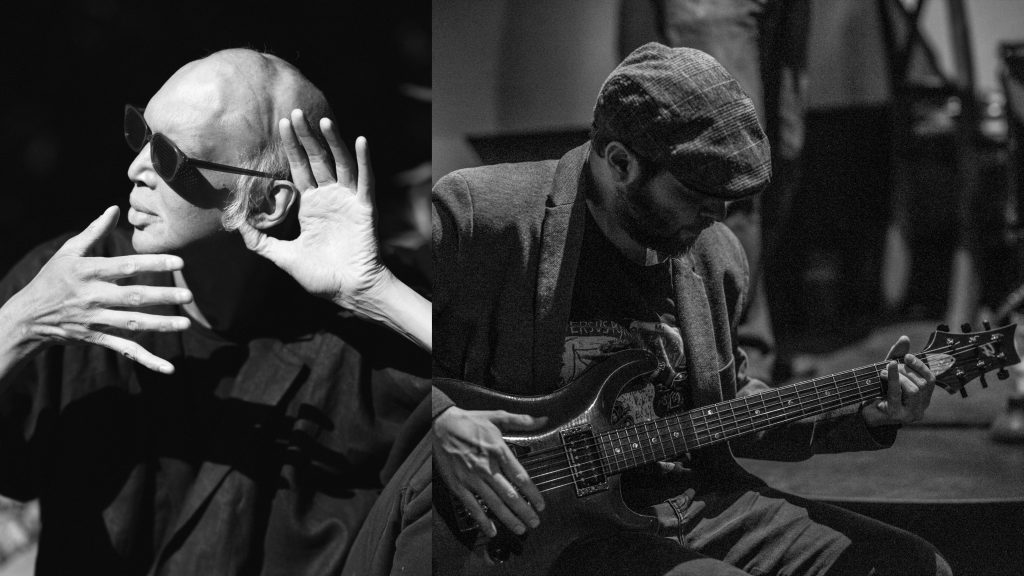
Shahzad Ismaily and Michał Dymny Duo
Pre-Opening Concert
Tuesday, September 5 at 5pm
Thomas Erben Gallery
526 West 26th Street, Floor 4, New York NY 10001
Shahzad Ismaily (How Shahzad Ismaily Became Musicians’ Favorite Musician – The New York Times) is a Brooklyn-based musician, composer and engineer. Born to Pakistani immigrant parents, he grew up in a wholly bicultural household. Exploring improvisation, tonal shifts and rhythmic movement, Ismaily worked with a number of avante-garde musicians and composers including Laurie Anderson, Anthony Coleman, Milford Graves, Eyvind Kang, Butch Morris and Marc Ribot. Over the last thirty years he has played electric bass, drums, percussion, guitar, synthesizers and all manner of sound-makers procured in life’s travels.
Michał Dymny is a multi-instrumentalist, improviser, composer and vocalist. His main instruments are piano and electric guitar, on which he has developed an individual style based on sonoristic techniques and preparations of the instrument. Dymny is an active member of the Polish improvised music scene. He was part of the Improvising Artists collective, as well as in projects Entropy, Process – Laboratory of Intuition, and Krakow Improvisers Orchestra. In 2008-2009 Dymny was organizing Open Sessions – regular meetings for improvising musicians. In 2013 he co-founded the Institute of Intuition – a project dedicated to the development of indeterministic forms of artistic creation.
Conceptually minded, Thomas Erben Gallery strives to either rediscover or expose work that contributes to contemporary discourse and expands beyond the boundaries of the artists’ chosen media. Thomas Erben began his professional involvement in the art world in 1989 as a private dealer focusing on contemporary American art. In 1993, he began organizing exhibitions in his private space, which led to the opening of Thomas Erben Gallery, located, until 2000, on Broome Street in SoHo. His inaugural exhibition in September of 1996 was an installation by Senga Nengudi. From the outset, the program has been multidisciplinary and internationally oriented, showcasing emerging as well as established artists.
Lead image: Agata Kus, Medusa, 2023. Oil on tulle, embroidery.


